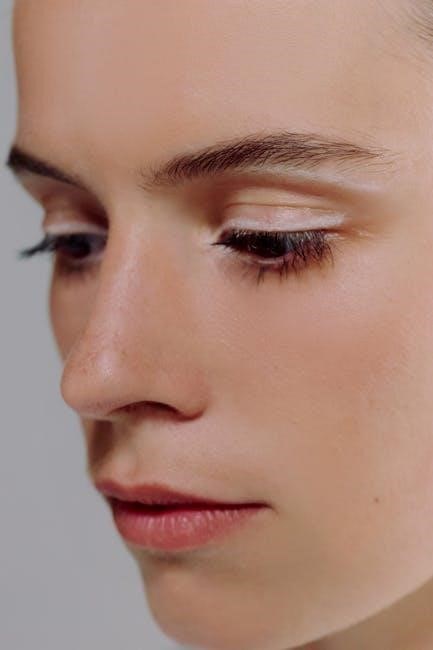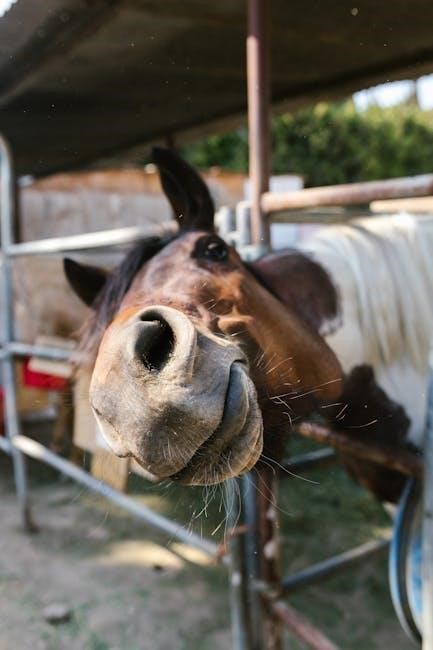The Nose Method offers a comprehensive guide to transforming your nose shape through various techniques, enhancing confidence and aesthetic appeal without invasive procedures.
Understanding the Importance of Nose Aesthetics
The nose is a central feature of the face, significantly influencing overall appearance and self-perception. Nose aesthetics play a crucial role in balancing facial harmony, with even minor changes impacting self-confidence. Many individuals seek nose transformation to address concerns like asymmetry, size, or shape, which can affect self-esteem. The Nose Method emphasizes the psychological and emotional benefits of achieving a desired nasal form, whether through surgical or non-invasive means. Advances in techniques, such as fillers and plasma fibroblast treatments, have made it more accessible to alter nose shape without surgery. Understanding the importance of nose aesthetics helps individuals make informed decisions about their transformation journey, aligning their goals with their personal vision of beauty and confidence.
The Evolution of Nose Transformation Methods
Nose transformation methods have evolved significantly over time, from ancient techniques to modern advancements. Historically, nose reshaping was limited to surgical procedures, often risky and rudimentary. In the late 19th and early 20th centuries, rhinoplasty began to emerge as a refined surgical practice, focusing on correcting deformities and enhancing aesthetics. Today, the field has expanded to include both invasive and non-invasive approaches, offering tailored solutions for diverse needs. Surgical methods like grafting and septoplasty remain popular, while non-surgical options, such as fillers and plasma fibroblast treatments, provide temporary yet effective alternatives. The Nose Method reflects this evolution, blending traditional principles with cutting-edge techniques to cater to individual preferences and deliver natural-looking results. This progression underscores the growing demand for safe, customizable, and less risky solutions in nose transformation;

Surgical Methods for Nose Transformation

Rhinoplasty remains a cornerstone of surgical nose transformation, offering precise reshaping through grafting techniques and septoplasty to correct structural issues and enhance both aesthetics and functionality.
Rhinoplasty: An Overview
Rhinoplasty, commonly known as a nose job, is a surgical procedure designed to reshape and refine the nose for aesthetic or functional purposes. It involves modifying the nasal bones, cartilage, and soft tissues to achieve the desired appearance or improve breathing. Rhinoplasty can address a range of concerns, including a crooked nose, bulbous tip, or a deviated septum. Surgeons use advanced techniques, such as cartilage grafting, to strengthen and support the nasal structure. The procedure is typically performed under general anesthesia and may require several weeks of recovery. Open rhinoplasty involves an incision under the nasal tip, while closed rhinoplasty is done entirely inside the nostrils, leaving no visible scars. Both methods aim to deliver natural-looking results tailored to the patient’s facial features. Rhinoplasty is a popular choice for those seeking long-term solutions to nasal imperfections, enhancing both confidence and quality of life.
Open vs. Closed Rhinoplasty: Key Differences
When considering rhinoplasty, one of the primary decisions is choosing between open and closed techniques; In open rhinoplasty, a small incision is made under the nasal tip, allowing the surgeon greater visibility and access to the nasal structures. This method is often preferred for complex cases requiring significant reshaping. In contrast, closed rhinoplasty is performed entirely through the nostrils, leaving no visible scars and often resulting in a shorter recovery time. The choice between the two depends on the extent of changes needed and the surgeon’s expertise. Open rhinoplasty may offer more precision for intricate modifications, while closed rhinoplasty is ideal for less invasive adjustments. Both methods aim to achieve natural-looking results, but the approach varies based on individual needs and preferences. Understanding these differences helps patients make informed decisions about their procedure;
Grafting Techniques in Rhinoplasty
Grafting techniques play a crucial role in rhinoplasty, particularly for patients requiring structural support or augmentation. Surgeons often use cartilage grafts, harvested from the septum, ears, or ribs, to reshape the nose. These grafts can correct deformities, enhance the nasal bridge, or repair a deviated septum. The cartilage is carefully sculpted and placed to achieve the desired shape and stability. For instance, rib cartilage grafts are commonly used in complex cases, offering durability and strength. In some cases, synthetic materials or bone grafts may be employed as alternatives. Grafting techniques not only improve aesthetics but also restore nasal function, ensuring long-term results. Proper placement and shaping of grafts are essential to avoid complications and ensure a natural appearance. This method is particularly effective for patients with congenital defects or injuries affecting the nose. By strengthening the nasal framework, grafting enhances both form and function.
Correcting a Deviated Septum Through Surgery
A deviated septum is a common nasal issue where the thin wall of cartilage and bone separating the nostrils is misaligned. This can cause breathing difficulties, congestion, and sinus problems. Surgical correction, known as septoplasty, aims to straighten the septum and improve nasal function. During the procedure, the surgeon removes or repositions the displaced portions of the septum while preserving enough cartilage and bone to maintain nasal structure. The surgery is typically performed under general anesthesia and may be combined with rhinoplasty for cosmetic adjustments. Recovery involves managing swelling and avoiding strenuous activities for a few weeks. Septoplasty significantly improves breathing and reduces chronic sinus issues, offering long-term relief for patients with severe septal deviations. This procedure is often recommended when non-surgical methods fail to address the underlying anatomical issues. Proper post-operative care ensures optimal results and minimizes risks of complications.

Non-Surgical Methods for Nose Transformation
Nose fillers and plasma fibroblast techniques offer temporary to semi-permanent solutions for reshaping the nose without surgery. These methods provide aesthetic improvements with minimal downtime and reduced risks.
Nose Fillers: A Temporary Solution
Nose fillers are a popular non-surgical option for reshaping the nose, offering temporary results that can last several months to a few years. Dermal fillers, typically made of hyaluronic acid or calcium hydroxylapatite, are injected into specific areas of the nose to address concerns such as a crooked shape, a dorsal hump, or a flat bridge. The procedure is quick, usually taking 15–30 minutes, and requires minimal downtime. Fillers provide immediate results, allowing individuals to preview potential changes before committing to permanent solutions like surgery. However, they may need to be repeated to maintain the desired shape, and their effectiveness depends on the expertise of the practitioner. Nose fillers are an excellent choice for those seeking subtle, reversible improvements without the risks associated with invasive procedures.
Plasma Fibroblast Technique for Nose Reshaping
The plasma fibroblast technique is a non-invasive method used to reshape the nose by tightening the skin and stimulating collagen production. This procedure involves the use of a plasma pen, which emits energy to create micro-injuries on the skin’s surface, triggering a healing response. The result is a smoother, more defined nasal contour. Unlike surgery, this method has minimal downtime and offers a more permanent solution for addressing concerns like a crooked or asymmetrical nose. The technique is particularly effective for refining the nasal tip or straightening the bridge. While results may take weeks to fully appear, the plasma fibroblast technique provides a safer, less risky alternative to rhinoplasty for those seeking subtle improvements. It’s an ideal option for individuals who desire long-lasting changes without undergoing surgery.
Non-Invasive Nose Transformation Alternatives
Non-invasive nose transformation alternatives offer a range of options for those seeking to enhance their nasal appearance without surgery. These methods include nose fillers, which provide temporary shape adjustments, and the plasma fibroblast technique, which tightens skin and refines contours. Additionally, makeup tricks and nose exercises are popular choices for subtle, at-home transformations. These alternatives are ideal for individuals who prefer minimal risk and downtime, allowing them to achieve their desired aesthetic without the commitment of surgery. They provide a versatile approach to addressing various nasal concerns, from asymmetry to size, ensuring personalized results tailored to individual preferences.

Natural and Non-Invasive Techniques
Natural methods like nose exercises and breathing techniques can subtly reshape and improve nasal health. These non-invasive approaches offer a low-risk, cost-effective way to enhance your nose’s appearance and function.
Nose Exercises: Can They Change Nose Shape?
Nose exercises are a popular non-invasive method to subtly reshape the nose. These techniques, often promoted in guides like The Nose Method, involve specific movements and pressures applied to the nasal area. While they cannot drastically alter the nose’s structure, consistent practice may refine its appearance over time. Exercises like pressing the nose tip or using breathing techniques can help improve nasal symmetry and reduce bulbosity. However, results vary, and effectiveness depends on individual anatomy and dedication. Unlike surgical methods, nose exercises are low-risk, cost-effective, and suitable for those hesitant to undergo procedures. They are particularly appealing for minor adjustments or as a complementary approach to other non-invasive techniques. Regular practice is key, but patience is essential, as noticeable changes may take months to develop. Overall, nose exercises offer a natural way to enhance nasal aesthetics without the risks of surgery.
Makeup Tricks for Reshaping the Nose
Makeup is a versatile tool for reshaping the nose without surgery. Techniques like contouring can create the illusion of a slimmer, straighter, or more defined nose. Start by applying a highlighter down the bridge to elongate the nose, then use a bronzer or contour powder on the sides to create shadow. This contrast narrows the appearance and enhances symmetry. For a shorter nose, apply darker shades to the tip and blend upward. To make the nose appear more proportional, subtle shading can balance its shape. Blending is key for a natural look. While makeup doesn’t permanently change the nose, it offers a quick, non-invasive way to enhance its aesthetics. This method is ideal for special occasions or everyday use, allowing individuals to experiment with different looks effortlessly.
Breathing Techniques for Nasal Health
Breathing techniques play a vital role in maintaining nasal health and overall well-being. Practices like diaphragmatic breathing and alternate nostril breathing can enhance nasal function, improving airflow and reducing congestion. Diaphragmatic breathing strengthens the diaphragm, promoting efficient oxygen exchange. Alternate nostril breathing balances breathing patterns, which can help alleviate sinus pressure and improve respiratory function. These techniques not only support physical health but also contribute to mental relaxation and stress reduction. While they don’t change the nose’s appearance, they optimize its natural function, making them a valuable complement to other nose transformation methods. Regular practice can lead to better breathing habits and improved nasal hygiene, enhancing both health and confidence. Incorporating these exercises into daily routines can have long-term benefits for nasal health and overall quality of life. They are simple, non-invasive, and accessible to everyone, making them an excellent addition to any wellness regimen.

Considerations Before Transformation
Assess your budget, expectations, and psychological readiness before pursuing nose transformation. Consulting a specialist ensures safety and aligns your goals with achievable results, avoiding unrealistic outcomes.
Cost Considerations for Nose Transformation
Nose transformation costs vary widely based on the procedure type, surgeon expertise, and geographic location. Surgical rhinoplasty typically ranges from $3,000 to $15,000 or more, depending on complexity.
Non-surgical methods, like nose fillers, are generally more affordable, with prices starting at $500 to $2,000 per session, though results are temporary and may require repeat treatments.
Additional expenses include pre-procedure consultations, post-operative care, and potential Revision surgeries. Budgeting for these ensures a comprehensive financial plan tailored to your transformation goals.
Psychological Impact of Nose Transformation
Nose transformation can profoundly affect self-perception and confidence. Many individuals experience heightened self-esteem after achieving their desired nasal shape, as it aligns with their ideal appearance. This change can reduce self-consciousness and improve overall mental well-being.
However, psychological impacts vary. While some find empowerment, others may face pressure to meet societal beauty standards. The decision to undergo transformation should consider emotional readiness and personal motivations, ensuring it aligns with self-acceptance rather than external expectations.
Studies show that patients often report improved emotional health post-procedure, particularly when addressing functional issues like breathing difficulties. The emotional benefits of nose transformation highlight its role in enhancing both aesthetics and quality of life.
Choosing the Right Surgeon or Specialist
Selecting the right surgeon or specialist is critical for a successful nose transformation. Ensure they are board-certified and have extensive experience in rhinoplasty or non-surgical methods. Research their credentials and review patient testimonials to assess their expertise and results.
Experience matters; look for specialists who frequently perform nose procedures and have a portfolio of diverse cases. A skilled surgeon will understand your goals and tailor the approach to your unique facial structure and needs;
During consultations, discuss your expectations openly and ensure the surgeon listens and provides personalized advice. A good specialist will also address potential risks and guide you through the decision-making process. Choosing the right professional ensures both safety and satisfaction with your transformation.

Post-Procedure Care and Recovery
Proper care post-procedure ensures optimal healing and results. Rest, hydration, and avoiding strenuous activities are crucial. Follow instructions to minimize risks and support recovery effectively for a smooth transformation.
Aftercare for Surgical Nose Transformation
Proper aftercare is essential for a successful surgical nose transformation. Immediately following the procedure, patients should rest with their head elevated to reduce swelling. Avoiding strenuous activities, bending, or heavy lifting is crucial during the initial recovery period. Gently cleaning the nasal area with saline sprays or solutions, as directed by your surgeon, helps prevent infection. Refraining from blowing the nose and avoiding tight clothing that may rub against the nose are also important. Pain management should be handled with prescribed medications, and patients should adhere to a soft-food diet to minimize discomfort. Keeping follow-up appointments ensures proper healing and addresses any concerns. By carefully following these guidelines, patients can optimize their recovery and achieve the best possible results from their nose transformation.
Recovery Time for Non-Surgical Methods
Non-surgical nose transformation methods typically require minimal recovery time, making them a convenient option for many. For procedures like nose fillers, most patients resume daily activities within 24-48 hours, with mild swelling or bruising subsiding within a week. Plasma fibroblast techniques may involve a slightly longer recovery, often 7-10 days, as the skin needs time to heal. After non-surgical procedures, it’s important to avoid strenuous activities, direct sun exposure, and heavy makeup to ensure optimal results. Patients should follow specific aftercare instructions, such as using cold compresses to reduce swelling or avoiding certain medications. The temporary nature of these methods means touch-ups may be needed to maintain the desired shape. Overall, non-surgical nose transformation offers a quick recovery, allowing individuals to achieve aesthetic improvements with minimal downtime. Proper care during this period is crucial for achieving the best outcomes.
Managing Risks and Complications
While nose transformation methods are generally safe, understanding potential risks and complications is essential. For surgical procedures like rhinoplasty, risks may include infection, scarring, or nasal asymmetry. Non-surgical methods, such as fillers, can cause temporary swelling, bruising, or uneven results. To minimize these risks, choosing a qualified surgeon or specialist is crucial. Proper aftercare, including following post-procedure instructions and attending follow-up appointments, helps ensure optimal outcomes. Patients should also be aware of rare complications, such as filler migration or allergic reactions, and seek immediate medical attention if they occur. By adhering to professional guidance and maintaining realistic expectations, individuals can effectively manage risks and achieve satisfying results from their nose transformation. Open communication with a specialist is key to addressing any concerns and ensuring a smooth recovery process.